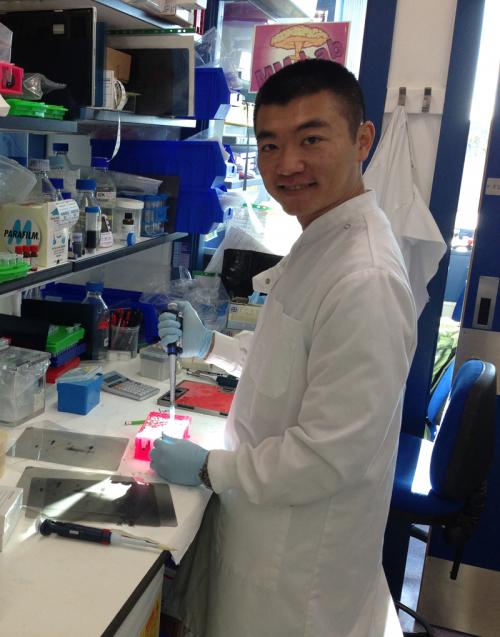
Yu-Chiang and Chandana discover Rab GTPases as new targets of PINK1
A major focus of research at the MRC PPU is directed at understanding the molecular basis of neurodegenerative diseases such as Parkinson's since there are no available disease-slowing therapies for these devastating diseases.
To date ~20 genes have been identified in familial Parkinson's patients including mutations in the mitochondrial protein kinase, PINK1 (PTEN-induced kinase 1).
The Muqit lab has been investigating the regulation and downstream signalling of PINK1 and previously discovered that PINK1 is activated upon mitochondrial depolarisation and phosphorylates Serine 65 of the N-terminal ubiquitin-like domain of Parkin as well as ubiquitin itself to maximally stimulate Parkin ubiquitin E3 ligase activity.
A major question in the field was whether PINK1 had additional targets and in a joint collaboration, the Muqit lab teamed up with the laboratory of Matthias Trost to employ state-of-the-art subcellular phosphoproteomics to address this important question.
Amongst nearly 15,000 phosphosites isolated from cells expressing active PINK1, Chandana Kondapalli (a former PhD student in the Muqit lab) and Matthias excitingly discovered three members of a sub-family of Rab GTPases, namely Rab8A, 8B and 13 that were all phosphorylated at a highly conserved residue, Serine111, in response to PINK1 activation.
Post-doctoral scientist, Yu-Chiang Lai, next undertook a series of a biochemical experiments to validate the physiological relevance of these novel PINK1 targets. Using phospho-specific antibodies raised against Ser111, Yu-Chiang demonstrated that Rab Ser111 phosphorylation is absolutely PINK1 dependent and abolished in HeLa PINK1 knockout cells. Furthermore, using human patient derived fibroblasts obtained from Olga Corti's lab in Paris, he further showed that Rab phosphorylation is totally disrupted in patients harbouring PINK1 mutations.
To investigate the impact of phosphorylation on Rab GTPase function, Aymelt Itzen's laboratory at the TUM in Munich undertook biophysical analysis using phosphomimetic versions of Rab8A. Strikingly the Itzen lab found that Rab Ser111 phosphorylation dramatically impaired Rab8A activation by its physiological guanine exchange factor, Rabin8 suggesting that PINK1 activation leads to inhibition of Rab function.
Yu-Chiang's new findings suggest that monitoring phosphorylation of Rabs at Ser111 may represent novel biomarkers of PINK1 activity in Parkinson's patients. Yu-Chiang's analysis has also revealed that PINK1 does not directly phosphorylate Rabs suggesting the existence of an intermediate kinase or phosphatase that is regulated by PINK1 and in future work it will be exciting to identify the Rab Ser111 kinase.
To read a copy of Yu-Chiang's paper published in The EMBO Journal click here.
To date ~20 genes have been identified in familial Parkinson's patients including mutations in the mitochondrial protein kinase, PINK1 (PTEN-induced kinase 1).
The Muqit lab has been investigating the regulation and downstream signalling of PINK1 and previously discovered that PINK1 is activated upon mitochondrial depolarisation and phosphorylates Serine 65 of the N-terminal ubiquitin-like domain of Parkin as well as ubiquitin itself to maximally stimulate Parkin ubiquitin E3 ligase activity.
A major question in the field was whether PINK1 had additional targets and in a joint collaboration, the Muqit lab teamed up with the laboratory of Matthias Trost to employ state-of-the-art subcellular phosphoproteomics to address this important question.
Amongst nearly 15,000 phosphosites isolated from cells expressing active PINK1, Chandana Kondapalli (a former PhD student in the Muqit lab) and Matthias excitingly discovered three members of a sub-family of Rab GTPases, namely Rab8A, 8B and 13 that were all phosphorylated at a highly conserved residue, Serine111, in response to PINK1 activation.
Post-doctoral scientist, Yu-Chiang Lai, next undertook a series of a biochemical experiments to validate the physiological relevance of these novel PINK1 targets. Using phospho-specific antibodies raised against Ser111, Yu-Chiang demonstrated that Rab Ser111 phosphorylation is absolutely PINK1 dependent and abolished in HeLa PINK1 knockout cells. Furthermore, using human patient derived fibroblasts obtained from Olga Corti's lab in Paris, he further showed that Rab phosphorylation is totally disrupted in patients harbouring PINK1 mutations.
To investigate the impact of phosphorylation on Rab GTPase function, Aymelt Itzen's laboratory at the TUM in Munich undertook biophysical analysis using phosphomimetic versions of Rab8A. Strikingly the Itzen lab found that Rab Ser111 phosphorylation dramatically impaired Rab8A activation by its physiological guanine exchange factor, Rabin8 suggesting that PINK1 activation leads to inhibition of Rab function.
Yu-Chiang's new findings suggest that monitoring phosphorylation of Rabs at Ser111 may represent novel biomarkers of PINK1 activity in Parkinson's patients. Yu-Chiang's analysis has also revealed that PINK1 does not directly phosphorylate Rabs suggesting the existence of an intermediate kinase or phosphatase that is regulated by PINK1 and in future work it will be exciting to identify the Rab Ser111 kinase.
To read a copy of Yu-Chiang's paper published in The EMBO Journal click here.

